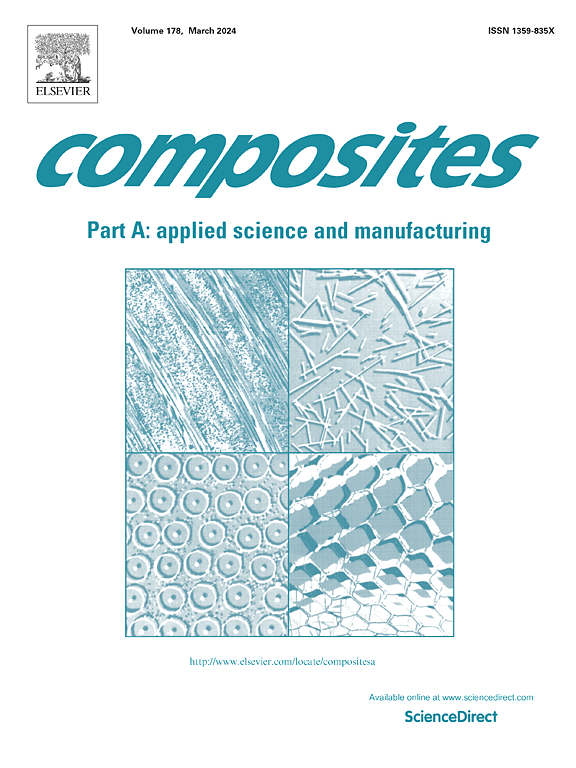Eco-friendly, mechanically robust, weather-resistant and rapidly cured polyurea elastomer synthesized by vat photopolymerization 3D printing
IF 8.1
2区 材料科学
Q1 ENGINEERING, MANUFACTURING
Composites Part A: Applied Science and Manufacturing
Pub Date : 2025-04-23
DOI:10.1016/j.compositesa.2025.108985
引用次数: 0
Abstract
Vat photopolymerization (VP) 3D printing is increasingly employed for efficient elastomer production. However, the printed elastomers often exhibit unsatisfactory mechanical properties, and the process involves harmful volatile substances. Polyurea elastomers, which have a fast reaction rate and high viscosity during synthesis, pose challenges for solvent-free or diluent-free VP 3D printing. This study developed an eco-friendly, mechanically robust and rapidly cured polyurea elastomer by VP 3D printing. The synthesis rate and viscosity of polyurea prepolymer were reduced by controlling the reaction time and stirring speed for reactions without solvent and diluent. Novel urea-acryl resins were designed by employing two acrylic monomers. The mechanical properties of the UV-cured polyurea elastomer were further enhanced through graphene incorporation. The polyurea/graphene nanocomposite at an optimal graphene loading of 0.10 wt% exhibited tensile strength of 12.9 MPa, and elongation at break of 399.2 %. These values correspond to increments of 76.7 % and 66.8 %, respectively, over the neat DLP polyurea elastomer. Moreover, these photocured elastomers exhibited excellent recyclability and weather resistance. The innovative synthesis strategy offers a solution to the mechanical limitations of photocured resins while minimizing environmental impact.

通过还原光聚合3D打印合成的环保、机械坚固、耐候、快速固化的聚脲弹性体
还原光聚合(VP) 3D打印越来越多地用于高效弹性体生产。然而,打印的弹性体往往表现出令人不满意的机械性能,并且该过程涉及有害的挥发性物质。聚脲弹性体在合成过程中具有快速反应速率和高粘度,这对无溶剂或无稀释剂的VP 3D打印提出了挑战。本研究通过VP 3D打印技术开发了一种环保、机械坚固、快速固化的聚脲弹性体。在无溶剂和无稀释剂的情况下,通过控制反应时间和搅拌速度,降低聚脲预聚物的合成速度和粘度。采用两种丙烯酸单体设计了新型脲腈树脂。石墨烯的掺入进一步提高了uv固化聚脲弹性体的力学性能。当石墨烯负载为0.10 wt%时,聚脲/石墨烯纳米复合材料的抗拉强度为12.9 MPa,断裂伸长率为399.2%。这些值分别对应于纯DLP聚脲弹性体的76.7%和66.8%的增量。此外,这些光固化弹性体表现出优异的可回收性和耐候性。创新的合成策略为光固化树脂的机械限制提供了解决方案,同时最大限度地减少了对环境的影响。
本文章由计算机程序翻译,如有差异,请以英文原文为准。
求助全文
约1分钟内获得全文
求助全文
来源期刊

Composites Part A: Applied Science and Manufacturing
工程技术-材料科学:复合
CiteScore
15.20
自引率
5.70%
发文量
492
审稿时长
30 days
期刊介绍:
Composites Part A: Applied Science and Manufacturing is a comprehensive journal that publishes original research papers, review articles, case studies, short communications, and letters covering various aspects of composite materials science and technology. This includes fibrous and particulate reinforcements in polymeric, metallic, and ceramic matrices, as well as 'natural' composites like wood and biological materials. The journal addresses topics such as properties, design, and manufacture of reinforcing fibers and particles, novel architectures and concepts, multifunctional composites, advancements in fabrication and processing, manufacturing science, process modeling, experimental mechanics, microstructural characterization, interfaces, prediction and measurement of mechanical, physical, and chemical behavior, and performance in service. Additionally, articles on economic and commercial aspects, design, and case studies are welcomed. All submissions undergo rigorous peer review to ensure they contribute significantly and innovatively, maintaining high standards for content and presentation. The editorial team aims to expedite the review process for prompt publication.
 求助内容:
求助内容: 应助结果提醒方式:
应助结果提醒方式:


